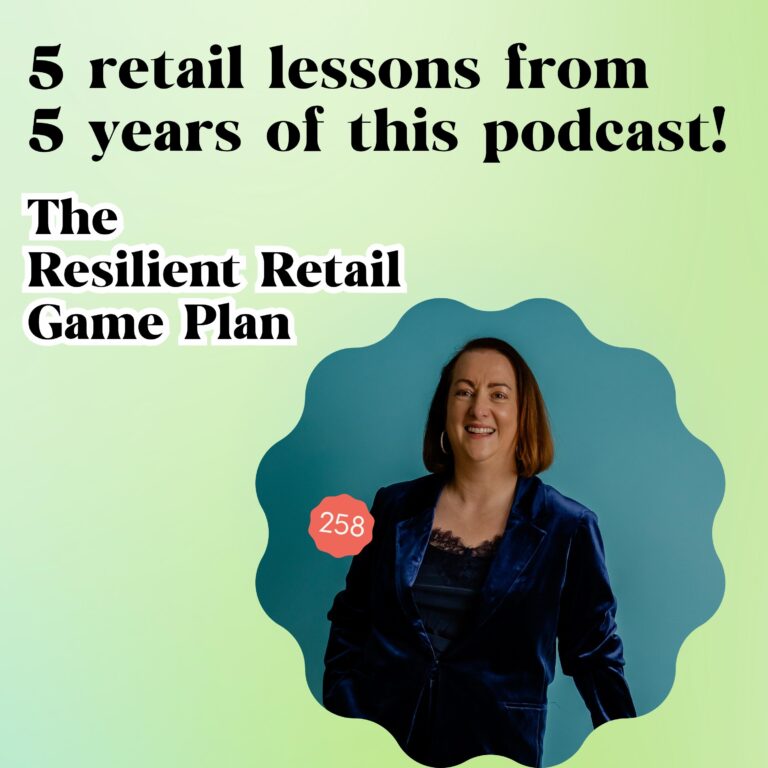Retail Customer Service Horror Stories!
A Customer Service Nightmare: The Faulty Frame
Catherine Erdly: Let’s start with a story. So a few years ago, I bought a sofa bed from John Lewis. I will name in shame. I’d spent ages and ages researching this sofa bed. And when it finally arrived, it was quite an expensive purchase. And, you know, we’d budgeted it, saved up for it and finally bought it and arrived. And it had an element of self assembly.
So it got delivered to us, the delivery people leave, we start putting it together and about halfway through putting it together, we realize there’s actually a fault with the frame. So where you’re supposed to have been able to screw a bolt into the frame, you couldn’t screw it in. It was actually welded shut.
So. This is now in the middle of our living room. We’re tripping over it. There’s pieces everywhere. So I called John Lewis and I explained the situation to them and they say, Oh, right. Okay. You know, I had to send them photos and basically prove I wasn’t making this up or incompetent at putting things together.
They agreed that it was in fact faulty and they said they’d come and get it and deliver a new one. But then what happened was that they just never really followed up. I didn’t hear anything. I was having to do all the chasing and I would call them and then eventually they’d say, Oh yeah, we’ve got that on a list and you know, we’re going to contact the supplier, but we don’t know.
We’ve emailed the supplier, but we haven’t heard back. And I said, well, okay, this is, yeah. You know, this was like days later now, like five, six, seven days later. And I was like, can you just call them? Can you just pick the phone up and call the supplier? Because I’m stuck here with this disassembled sofa bed in the middle of my living room and it’s massive pain.
And in the end I got so irate, not my finest moment to be fair. And I sent one of these emails. Find the CEO of John Lewis. And I just wrote to them and I said, look, this is not great customer service. I’m having to do all the chasing. I’m having to ask you for an update. And I was thinking especially about all of you, small business owners, you would never leave somebody hanging in this situation like this.
Every small business owner I work with goes over and above for their customers to a huge degree, making sure that they get their products, that they’re happy with them. And this kind of thing just really gets under my skin. So I’d found the CEO email, and sent it to them. And I said, I bought from John Lewis because, laid it on a bit thick probably, I was working off your reputation and I really trusted you. And you’ve let me down. And because I’ve made this complaint to the CEO, I got a call from the special department, which was called something like the customer happiness department or something like that and all the customer satisfaction.
And basically what I got on the phone was a very well trained man whose main job it was to deal with really disgruntled customers.
Reflective Listening: A Customer Service Technique
Catherine Erdly: And I knew that he was very well trained because he was using something which is called reflective listening. Reflective listening. I actually found out about this when my children were very small and it’s for a book, which I recommend to everybody parent or not called how to talk so your children will listen and how to listen so your children will talk. And the idea is that if someone’s really upset about something, you let them rant and rave and you listen and you reflect back, wow, it sounds like you’re really upset. It sounds like this has been really frustrating for you.
And then. Once you’ve kind of listened to them and engaged with them and this works, whether or not it’s a cranky person with a faulty sofa bed or a small toddler, eventually they’ll calm down because they feel like you’ve heard what they’re saying. And then you can say to them, okay, This is what I think.
And then you can put your side across. Whereas if you just go straight in and say of course this is normal that it’s taken a week for us to send you a replacement, et cetera, et cetera. Then it really puts people’s hackles up. And this technique is so good. It means that you can have a conversation with anybody, even when they’re really upset because you’re not saying that they’re right, necessarily. You’re not giving in. You are just listening and reflecting back to them. And I remember using this when I worked after I discovered this technique for dealing with my cranky toddler. Then I used to use it and I would get calls sometimes when I worked in big retailers, the stores would call upset about something and I would do the same thing that this guy was doing to me.
Reflectively listen. And then at the end they would go, oh, I feel so much better. Thank you for listening. And I hadn’t actually said or done anything.
Halloween Special: Horrors of Customer Service
Catherine Erdly: So why am I telling you this story is because the theme of today’s episode, it’s Halloween when this episode is released. So I wanted to have a theme all about the horrors of customer service.
And I wanted to do it from both sides, not just from what you’ve experienced as business owners. And lots of you have shared your horror stories of what your customers have said and done, but also how it feels as a customer itself. And just reflecting a little bit on what great customer service looks like and how to navigate some of these things cause they’re really, really difficult.
Welcome to the Resilient Retail Game Plan, a podcast for anyone wanting to start, grow or scale a profitable creative product business with me, Catherine Erdly. The Resilient Retail Game Plan is a podcast dedicated to one thing, breaking down the concepts and tools that I’ve gathered from 20 years in the retail industry and showing you how you can use them in your business.
This is the real nuts and bolts of running a successful product business, broken down in an easy, accessible way. This is not a podcast about learning how to make your business look good. It’s the tools and techniques that will make you and your business feel good. Confidently plan, launch, and manage your products, and feel in control of your sales numbers and cash flow to help you build a resilient retail business.
Tips for Handling Unhappy Customers
Catherine Erdly: So that is one of my tips for you to start off with is to remember that often what the customer wants when they’re frustrated. I mean, there are definitely just really terrible, permanently angry, never happy customers. But a lot of the time people really want to be listened to.
And I certainly did calm down after the especially trained reflective listener listened to my complaints. And I also, another tip I would say, if you’re ever in the situation of being the unhappy customer is always be really clear about what you want. So do you just want to vent? Do you just want to make them aware that their custom service isn’t good enough?
Or in this case, I did say to them, I feel like I should have some kind of discount. Okay. Or part refund or something because I’ve spent a lot of time on this issue. And I did in fact get a John Lewis gift card, which was very much appreciated. So those are my tips. Look up how to talk. So your children will listen, how to listen.
So your children will talk or look up reflective listening because it’s a very useful technique for dealing with unhappy people. And it takes some of the pressure out of dealing with people when they’re unhappy because you can literally just reflectively listen and you don’t feel like you’re as under attack.
But then also from a customer perspective, if you’re ever in that situation, if you’re ever in a situation where you’ve got an unhappy customer, it’s always worth asking yourself, what do they really want? And do they maybe just want to be listened to? And is that something that you can do?
Real-Life Customer Service Horror Stories
Catherine Erdly: That was I think personally, one of the worst customer service experiences that I’ve had.
I asked people, as I said, for both sides, somebody also told me a story on Instagram DMs about how they walked into Tesco’s, they went up to the customer service desk, they were waiting to be served. And the customer service person answered the phone and was on the phone to somebody for a while. And they said to the customer who was waiting, Oh, sorry, but I had to pick up in case it was somebody important. So then, which basically suggested that the customer wasn’t important.
So I think that’s a really great example of when we think about bad customer experiences is often to do with how the business has made us feel. That’s the thing that really makes us irate. So this stuck in her mind because the business basically told her that she wasn’t important. So how you make your customers feel is absolutely key.
Another example that somebody gave was that as a customer from a customer perspective was that they had sent back an order and they refunded them the money, but minus the delivery fee, and this person runs an online business.
So they knew that they should have had the delivery fee refunded, but the company said, well, you hadn’t actually canceled the order through our online order cancellation portal.
Refund Policies and Customer Retention
Catherine Erdly: So you’re not eligible for the delivery fee to be refunded. As if sending the order back, wasn’t canceling it. So I think this is an example of sometimes when there are processes and procedures in place, like common sense, you know, in that case, I would always suggest to people, if in doubt, give the customer their money back.
I mean, there are times. where for sure if you have a customer who you suspect or feel is really fraudulently trying to claim money back from you, but most of the time the best solution for these sort of little niggles like this, it’s especially if it’s a few pounds for a delivery fee, then again, it’s about you showing the customer how important they are to you, how you can make the customer feel.
And I always think about that statistic. It costs seven times as much money to acquire a new customer as it does to keep an existing customer. And we’ve all seen how much it costs to actually pay to acquire customers. So for sure, part of the customer service equation that you do in your head has to be about how much easier is it going to be for me if I feel if I can keep this customer as opposed to having to go out there and get a new one.
The Importance of Communication
Catherine Erdly: But I definitely think that what I learned from my own bad experiences as a customer and other people’s is the main frustrations are about that communication. So if in doubt, just make sure you’re communicating. Ask yourself, how am I making my customers feel? And maybe try a little bit of reflective listening if you can bear it.
The problem with reflective listening that I’ve found personally, especially as a parent, is that it requires you to be in a really calm headspace . You yourself have to have control of your own emotions because you have to be able to take whatever people are saying, however ridiculous and reflect it back to them without adding outrage or getting Triggered yourself.
So I definitely think that it’s not always easy, but it is really amazing. And if you do ever have people who are difficult, it is incredible how quickly people will switch when they feel like you’re listening to them because all of a sudden they go from being ready for a fight to realizing actually know the other person is telling them they get it and they understand.
So let’s look at the flip side then. What have you yourself experienced as a business owner?
And I wanted to share some of these stories because I know that one of the things that makes it really hard being a retailer or e commerce business is that it can feel like sometimes you’re the only one going through this and you absolutely 100 percent are not.
So some of The themes that came up time and time again, I’ve actually just grouped them together because they fall into certain categories, but people get all kinds of complaints from customers, but they are as much as they’re all different. They’re also have some real universal themes. So I hope that you find this comforting to know that you’re not the only one.
Handling Lost Parcels and Fraudulent Claims
Catherine Erdly: So one of the first things is One of these tricky things is people reporting parcels that are lost. And this is one which is really difficult to deal with, and often businesses will ask. This comes up a lot inside the Resilient Retail Club Facebook group, for example. So this is one of those things that is really difficult to deal with, especially when it’s a high value order.
And most of the time it is something that again, in an ideal world, you would be able to refund them if there’s because it’s a gray area is really what it boils down to. So we had some sessions within the Resilient Retail Club a couple of years ago with Eggbay Manton from Manton Legal. She went over all of the distance regulations and.
What it really boils down to is that it’s pretty much a gray area. Use the business are responsible for the product until it gets to the customer. But it’s a really tricky one when the customer says that it’s not arrived and the delivery company, for example, says it has, or even has photographic evidence.
And this is one of those ones where it can turn into a, he said, she said. We had one person who shared in the group that actually they were in a Facebook group of other people selling similar products to them. And they actually found that there was serial return, serial claimers, people who would order from multiple different businesses and then claim they never received it.
So in that case, it’s fairly obvious. And sometimes these people will get flagged because if they’re constantly putting in refund requests or opening disputes it can have an impact, but the majority of the time, and it’s, and there’s all, obviously it’s really hard to know whether or not somebody’s genuine or not, but the majority of the time it’s probably the best thing that you can do is to give, to offer, to replace it, to refund.
Dealing with Difficult Customers
Catherine Erdly: Now, obviously if somebody crops up doing this multiple times, or actually, to be honest, the other thing to say as well is, It’s okay to have boundaries. If you’ve got a customer, I remember somebody telling me who organizes events that they had someone who came to their event and then complained about it a lot the next year and then complained about it.
I think even wanted money back on their ticket. And then they came again the following year and then complained about it hugely afterwards. And then the third year they actually booked the ticket again. And this person just canceled the order and just said, you know what? Actually, I think we’re good.
And it’s okay to have those boundaries, it’s okay to not want to deal with people who are really difficult. So if you do have people who are repeat difficult customers, it’s okay to just cancel them. It’s okay to cancel if you think something’s fraudulent. It’s okay to protect yourself. That’s absolutely fine.
But if you think there’s a chance that it’s genuine, most of the time it is because it is such a gray area is better in my opinion, this is my opinion. legal advice have to say this. But in general, it’s definitely something that it’s better to smooth over and see if you can keep the customer happy.
The customer isn’t always right for sure, but most of the time it’s easiest to act as if they are.
The other thing that I hear a lot about are people, this is a great one, people reporting faults with products and then when you delve into it, they’re not actually your products. So there’s not really much you can do about that other than have a bit of a sense of humor about it.
But in fact, and somebody mentioned that they had someone who not only didn’t buy from them, bought from a competitor, but then that competitor’s parcel didn’t turn up and they were asking this person where the, what, if they knew anything about the product, which was just so not the way that the internet works, that you do wonder about some people sometimes.
So people often have unrealistic expectations. That is something else that happens a lot. People expecting immediate responses. Lots of the horror stories that people shared about customers were about people who immediately would ask where their parcel was or claim they wanted to refund state that they’d been cheated or that there was a fraud or something like that.
And actually they, the person’s already refunded them. So. There are definitely lots of people who are just completely irrational. People who are quick to demand a refund, claim that you’re a scammer. And I think the only thing that you can really do with a lot of these is try and keep as a clear head as possible.
So, First of all, know that it’s not just you. Everybody has very difficult customers from time to time. Hopefully only a very small percentage. Set clear expectations on when you will respond. People will expect immediate responses.
One of my favorite stories was a client told me that a customer messaged them on a Saturday and said, I’m on my way to Ikea. What size frame should I buy for your print? And then was really put out that they didn’t respond. And I think, you know, John Lewis don’t respond on a Saturday to customer service inquiries. I know lots of banks, medical companies, lots of people just don’t have weekend support. If you want to talk to somebody or get an answer, you’ve got to wait till the working week.
So I don’t think as small business owners, we have to feel that we absolutely have to respond all the time.
Setting Boundaries and Outsourcing Your Customer Service
Catherine Erdly: The other thing that I recommend is this is from the self help world, but they have this, the phrase HALT, H A L T, which stands for hungry, angry, lonely, tired. It’s a reminder to not deal with difficult things when you’re in one of those states, whether you are hungry, whether you are angry, whether you are lonely, or whether you’re tired.
Basically, this is not a good time for you to be dealing with your customer service queries. So I do recommend giving yourself really clear boundaries about when you will and when you won’t look at these kind of messages, because nothing will get you into a fight quicker than looking at your dms late at night, at Christmas when you’re tired and frustrated. So. Make sure you halt, think about that.
And then also at the end of the day, there are a lot of difficult people out there. Then is it something that you need to outsource? Other people will not feel nearly as upset and annoyed with people asking stupid questions or getting upset about minor things when it’s not their business.
There is a lot of power in outsourcing your customer services. I know it’s nice for you to talk directly to your customers and lots of people feel really strongly they want to be that voice and that’s fine. If you want to do that, then that’s fine. But if you find that you are just miserable because you’re dreading seeing what someone has sent you or messages that are coming up, especially during a busy time, then it is something worth experimenting with and seeing if you can outsource them.
Just to sum it up, then don’t forget about a lot of upset from customers will be about how you’re making them feel, whether that’s intentional, unintentional, usually unintentional. Have a look at reflective listening. It’s a very useful tool when it comes to dealing with angry people.
Don’t be alarmed when you do get these people from time to time, everybody does, everybody gets them. Absolutely. And try and protect yourself. Try and put something in place to look after yourself, whether that’s setting boundaries with times, making sure that you’re in the right headspace before you deal with customers and ultimately maybe outsourcing if it all becomes a bit too much. And hopefully you can avoid some true Halloween horrors.
Thank you so much for listening. If you have a moment to rate and review the podcast, it makes a huge difference to getting it out in front of other people. And don’t forget if you like subscribe or follow, then you’ll be the first to know about every new episode on a Thursday morning till next week.







